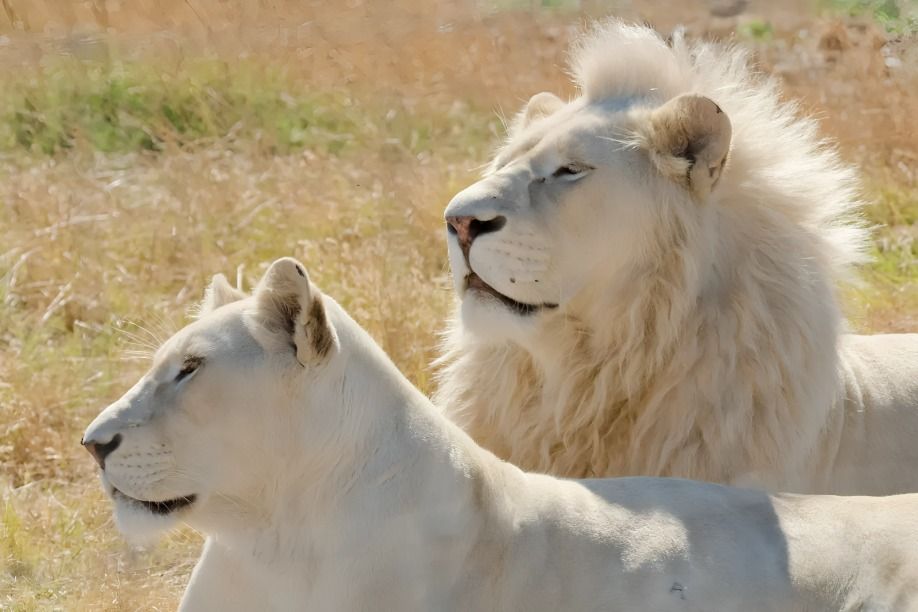
“
Lions, often referred to as the kings of the jungle, are among the most iconic and fascinating creatures in the animal kingdom. These majestic big cats are known for their strength, social structure, and impressive roars that can be heard miles away. In this blog, we delve into the world of lions, exploring 20 interesting facts that reveal the complexity and beauty of their lives. From their unique social behaviors to their crucial role in ecosystems, these facts will give you a deeper appreciation for these incredible animals.1
1
”
Lions are the only truly social cats, living in groups called pride that can consist of up to 30 individuals. A dominant male typically leads these prides. His role is to protect the pride's territory and offspring.1
Lions in the wild typically live for about 10 to 14 years. They can reach up to 20 years in captivity due to better care and lack of threats. Environmental conditions and human activities influence their lifespan.2
Lions communicate through roaring, which can be heard from up to 5 miles (8 kilometers) away. Roars serve various purposes, including territorial marking and calling for lost members. They also assert dominance within the pride.3
Male lions are recognized by their impressive manes, which vary in color from blonde to black. These manes serve as a visual indicator of their health and strength. The mane also provides protection during fights.4
Lionesses within a pride often synchronize their pregnancies and cooperate in raising cubs. They suckle each other's young and protect them fiercely from predators. These predators include hyenas and leopards.5
Lions mark their territories with urine, feces, and distinctive roars. This territorial behavior helps prevent conflicts with neighboring prides. It also defines areas rich in prey resources.6
Lions are primarily nocturnal hunters, resting during the day to conserve energy for hunting at dusk and dawn. These times are cooler and offer better visibility. This behavior enhances their hunting efficiency.7

White lions feature in folklore, but the first confirmed sighting occurred in 1938. Joyce Little observed one in Timbavati, near Kruger National Park. Her family, landowners in Timbavati, were friends with President Paul Kruger, after whom the park is named.
Despite their size, lions can sprint at speeds of up to 50 mph (80 km/h) for short distances. This burst of speed is crucial for chasing down prey during hunts. Their agility complements their hunting prowess.8

African lions are classified as vulnerable by the IUCN due to habitat loss, human-wildlife conflict, and poaching. Conservation efforts aim to protect their remaining populations. Protecting their habitats is also essential.
Lions are voracious eaters, consuming up to 40 kg of meat in one meal, roughly a quarter of their body weight. Their tongues feature sharp, pointed papillae that help scrape meat off bones, facilitating efficient feeding.9
A lion's mane size and color reflect its health and age. Darker, fuller manes typically signal higher testosterone levels and increased chances of success in battles, providing an advantage in dominance and attracting potential mates.10
Lions are among the laziest of big cats. To conserve energy for hunting, they spend a significant portion of their day resting or sleeping, often up to 20 hours. This behavior is crucial for their survival.11
Male lions can weigh up to 30 stone, which is approximately 420 pounds (190 kilograms). This substantial weight reflects their powerful build and robust physique, essential for their role as apex predators in their natural habitats.12
Lionesses reach sexual maturity at around 3 to 4 years old. They can give birth to a litter of 1 to 6 cubs after a gestation period of approximately 110 days. Cubs are raised communally within the pride.13
The largest lion ever, a black-maned male named Simba, stood 1.11 meters tall at the shoulder. He lived at Colchester Zoo and later Knaresborough Zoo in the UK before passing away on January 16, 1973, at age 14.14
Lions are unique among big cats for their enjoyment of swimming. They frequently cool off in water bodies to regulate their body temperature and stay refreshed. This behavior distinguishes them from many other members of the feline family.15

A group of lions is called a pride. It includes one or more males, several related females, and their cubs. Females handle most of the hunting and cub-rearing, while males protect the pride from threats and rival males.
The largest lion subspecies, the American lion (Panthera leo atrox), lived in North America and possibly Peru. It went extinct over 11,000 years ago. This lion was 25% larger than modern African lions, measuring 1.6–2.5 meters in length.16
Conservation organizations and wildlife reserves work tirelessly to protect lion populations. They engage in habitat preservation and anti-poaching patrols. Community education programs aim to reduce human-wildlife conflict.17


